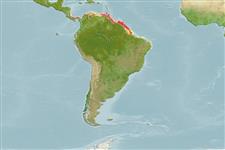Actinopterygii (ray-finned fishes) >
Mugiliformes (Mullets) >
Mugilidae (Mullets)
Etymology: Mugil: Latin, mugil, -ilis = grey mullet (Ref. 45335).
Environment / Climate / Range
Ecology
Marine; brackish; demersal; depth range 10 - ? m (Ref. 5217). Tropical, preferred ?; 13°N - 9°S
Western Atlantic: West Indies and the Atlantic coasts of Central and South America to southeastern Brazil.
Length at first maturity / Size / Weight / Age
Maturity: Lm ?, range 24 - ? cm
Max length : 40.0 cm TL male/unsexed; (Ref. 3791); 35.0 cm TL (female); common length : 25.0 cm TL male/unsexed; (Ref. 5217)
Mainly found in brackish estuaries but also in marine and hyper-saline waters (Ref. 5217). During reproduction, they gather in small groups at the mouth of coastal rivers and creeks. Reproduction occurs in the early part of the year. Oviparous, eggs are pelagic and non-adhesive (Ref. 205). Eggs which are rich in yolk are spawned by the millions. Upon hatching, juveniles move up to the swamps and coastal rivers over long distances, to seek for food and to protect themselves against predators (Ref. 35237). Marketed fresh or salted (Ref. 5217). The roe is marketed salt-pickled and dried and considered a delicacy (Ref. 5217).
Life cycle and mating behavior
Maturity | Reproduction | Spawning | Eggs | Fecundity | Larvae
Spawning seems to take place in small groups in river mouths. Females lay millions of relatively large eggs rich in yolk.
Thomson, J.M., 1978. Mugilidae. In W. Fischer (ed.) FAO species identification sheets for fishery purposes. Western Central Atlantic (Fishing Area 31). Vol. 3. [pag. var.]. FAO, Rome. (Ref. 3791)
IUCN Red List Status (Ref. 115185)
CITES (Ref. 94142)
Not Evaluated
Threat to humans
Harmless
Human uses
Fisheries: minor commercial
More information
ReferencesAquacultureAquaculture profileStrainsGeneticsAllele frequenciesHeritabilityDiseasesProcessingMass conversion
Tools
Special reports
Download XML
Internet sources
